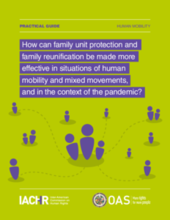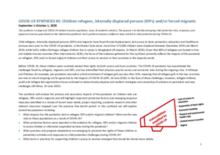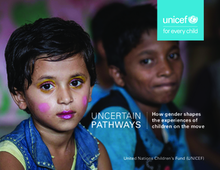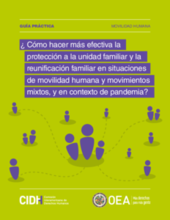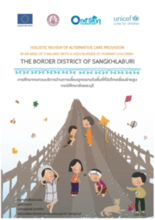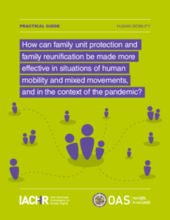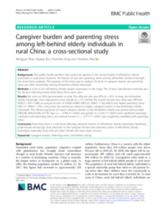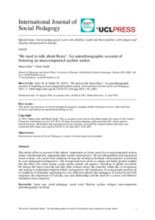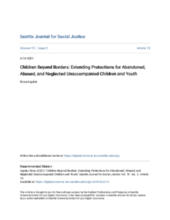Displaying 101 - 110 of 809
The guide recommends a series of measures aimed at States, which focus on protecting family unity, preventing separation, and ensuring reunification in the context of human mobility, including for unaccompanied or separated children and adolescents, who require international protection or who leave their homes in search of better opportunities or family reunification.
The purpose of this evidence synthesis is to analyze the primary and secondary impacts of the pandemic on children who are refugees, IDPs and/or migrants and highlights important protective factors and emerging response measures identified in a review of recent news media, project reporting, academic research and other relevant resources mapped over the previous five-month period.
Age plays a critical role in a child’s migration, but how will gender mediate that experience? Which gender-specific vulnerabilities, needs, and opportunities influence the lives of girls and boys on the move? This report reviews the existing evidence base – official statistics and quantitative and qualitative studies from the community level to the global level – to shed light on these important questions.
la Comisión Interamericana presenta la guía ¿Cómo hacer más
efectiva la protección a la unidad familiar y reunificar a la familia en los procedimientos migratorios y de protección en contexto de pandemia? en la que
se analizan los estándares interamericanos aplicables a la luz de las obligaciones
internacionales de los Estados y propone recomendaciones para garantizar la unidad
familiar y la reunificación familiar así como prevenir los riesgos de separación y minimizar los impactos en los casos de separación familiar. Asimismo, la implementación
de las garantías de la reunificación familiar requiere muchas veces de una estrategia idónea de acceso a mecanismos de regularización documental, así como de condiciones seguras de viaje y movilidad a través de las fronteras nacionales. Esto es especialmente benéfico para familias que se han visto separadas de manera forzada o por
razones asociadas a la movilidad humana.
This review was conducted in different forms of institutional care: private residential care, (charity) boarding schools, and temple as well as (informal) kinship care. The findings and recommendations were presented to the Thailand Provincial Social Development and Human Security Office and the Department of Children and Youth to further develop an alternative care road map and plan of action.
he Inter-American Commission on Human Rights (IACHR) has issued, in collaboration with the UN Refugee Agency (UNHCR), a practical guide on how to protect family unity and reunification more effectively in human mobility and mixed movement contexts during the ongoing COVID-19 pandemic. This publication is part of a series of guides issued by the IACHR to address the impact of the pandemic on human rights. The guide makes recommendations to States, so they may protect family unity, prevent separation, and take any necessary measures to ensure the reunification of families who may have been separated in contexts associated with human mobility.
The purpose of this study was to explore the level of caregiver burden and parenting stress and their relationship among left-behind elderly individuals.
This article offers an account of the authors’ experiences as foster carers for an unaccompanied asylum seeker (and through him, supporting other asylum-seeking boys).
This study examined the mental health of Middle Eastern male unaccompanied refugee adolescents in Germany in relation to the mental health of accompanied refugee peers, first- and second-generation immigrant and native peers.
This article argues that the U.S. Congress should make changes to extend protections under Special Immigrant Juvenile Status (SIJS). These implementations would give effect to the legislative intent behind SIJS, which is to protect the particularly vulnerable group of unaccompanied children and youth.

